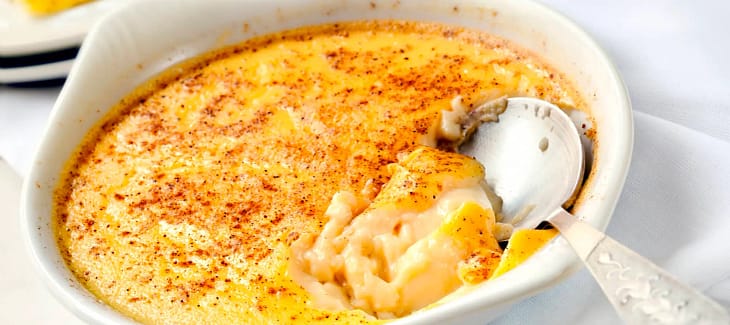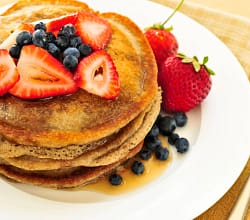Egg custard is like egg casserole, but with a unique dessert twist to it. You can eat it one of two ways-either as a warm, filling breakfast meal, or as a cold, creamy custard dessert.
Despite containing only 7 key ingredients, it is large and hearty enough to serve the whole family. Even better, you can store it overnight like overnight oats and take it out first thing in the morning for a speedy breakfast.
There are plenty of different ways to make egg custard, but this recipe will only cover the standard baked custard. Some other ways to make egg custard include Bavarian cream, crème brulee, cream pie, flan, and many more.
How To Keep Your Egg Custard Smooth and Firm
Custard is notorious for having inconsistencies in texture and taste. It’s a delicate recipe, so being mindful and aware when baking it can go a long way. There are a few things you can do to make sure your custard comes out smooth and firm.
All forms of custard come from a stable base of eggs, sugar, and milk. High-quality custard is reliant on these ingredients being heated by just the right amount, which causes them to thicken during baking.
Egg proteins coagulate when heated, but because they are being diluted by the milk and sugar, the egg custard must reach a higher internal temperature for this to happen. Your stove should heat to a maximum of 325 F (163 C) when baking your egg custard, for about 45 minutes.
Do not overheat the custard. When you overheat your custard (or most foods for that matter), there is no going back, and your custard will turn grainy and unpleasant. The best thing you can do to prevent this is to check your egg custard at every 5-minute interval during baking, starting at minute 30. So, during the 40-45 total minutes it takes to bake the custard, open your stove and check the custard’s texture on minutes 30, 35, 40, and 45. Ideally, you will be able to take it out when you are satisfied with the result.
Note that interval checking is not mandatory, and the more you repeat the recipe, the more likely you will be to know when it finishes.

Testing Your Finished Egg Custard
How do you know if your custard is done or not? Quite simply, the top of the custard will be quite bouncy and firm when it is ready. If you slide your finger across it, the surface will move slowly and it won’t be runny. If you dig into it with a spoon, it should scoop like soft ice cream, with little to no discontinuity. It should also have nice, crisp edges and a golden surface. All of these factors indicate that the egg proteins have coagulated, and it is safe to remove it.
The good thing about egg custard is that you don’t have to worry about it being undercooked, since eggs are very generous when it comes to their baking quality. Look for a smooth, firm, but still solid texture when checking it.
How To Make Your Egg Custard Creamier
If you prefer a creamier custard over a firm custard, use more egg yolks in place of whole eggs. Creamy custard is optimal for storing overnight, since it is able to retain its moisture and quality better than firm custard.
Simply separate the egg whites from your whole eggs and use the egg yolks for the recipe. 2 egg yolks are required at minimum to make the custard. You can then store the egg whites in a separate ramekin and use them for other recipes!

Traditional Baked Egg Custard
Equipment
- 1 whisk
- 1 saucepan
- 1 medium bowl
- 1 medium/large casserole dish size 9×13 preferred, or you can use small 4-ounce cups instead
- 1 strainer
Ingredients
- 4 large eggs
- 2 egg yolks
- ½ cup white or brown sugar
- 3 cups reduced fat (2%) milk or any non-dairy milk
- 1 tsp vanilla extract
- ½ tsp ground nutmeg/cinnamon
- ½ tsp salt
Instructions
- Preheat your oven to 325°F (163°C). Get out a large saucepan and pour your milk into it.
- Heat the milk over your stove on medium-low heat until it simmers and bubbles start to form around the edges.
- Get out a medium bowl and whisk together the eggs, yolks, sugar, salt, and vanilla until evenly combined. Pour the heated milk in after and whisk again.
- Pour the mixture in your casserole dish/oven-resistant small cups, making sure it gets strained with a strainer while pouring. Add in ground nutmeg/cinnamon.
- Fill the mixture with hot water until the casserole dish reaches 1 inch from the top. If you are using small cups, fill the cups with hot water until they reach about halfway from the top.
- Place the egg custard in your preheated oven and bake until the custard sets, which should take around 40-45 minutes. Do not bake longer than 45 minutes.
- Take out the custard when it becomes soft and firm. Let it cool for 5-10 minutes before serving.
How To Store Leftover Custard
Cover your custard pan, cup, or bowl in plastic wrap and place it in your fridge to cool. This is essential if you want to serve it cold. If you are storing your custard directly after baking it, allow it to cool for 5-10 minutes first. Chilled custard can last up 3 days in prime condition.
Freezing your custard, however, is a more involved process. To freeze your custard, first store it in a freezer-safe container and cover the lid tightly. After placing it in your freezer, whisk the contents of your custard every 30 minutes for the first three hours. This will aerate the custard, enabling it to freeze safely. After the 3 hours, you can leave it in as normal, and it may last up to a month.
When defrosting, leave the custard container on your tabletop and let it thaw out for 3-4 hours. Be sure to whisk the custard smoothly when it becomes less icy.






